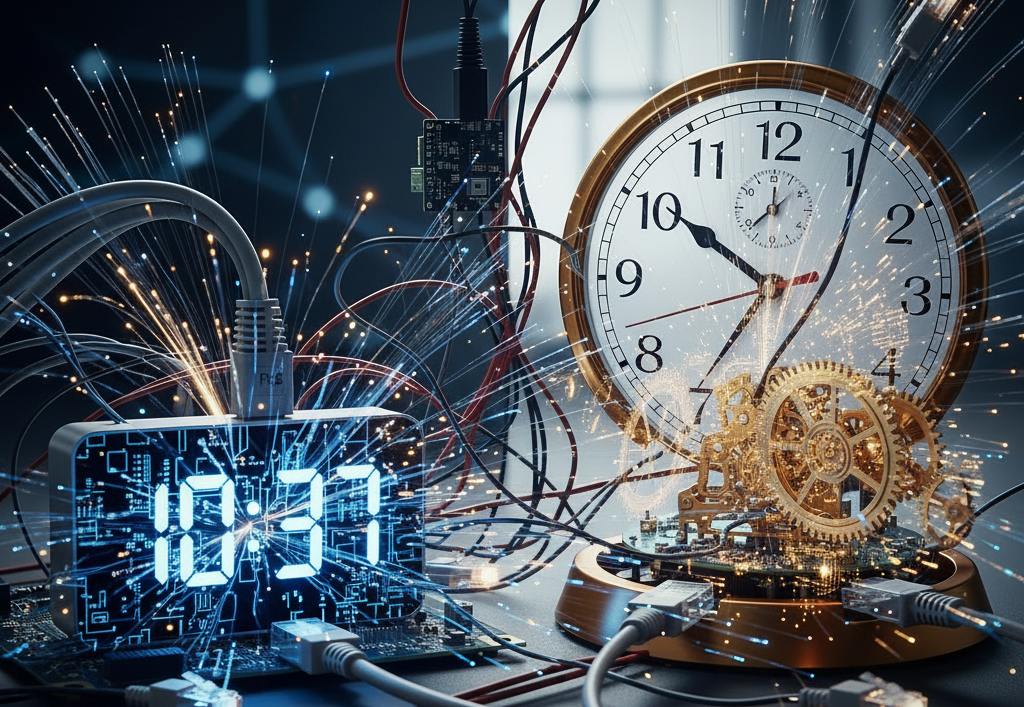Accurate time isn’t just a convenience – it is a critical factor in maintaining compliance, productivity, and safety across modern enterprises. Whether in education, healthcare, public safety, manufacturing, or corporate environments, synchronized timekeeping provides the structure organizations need to operate smoothly and efficiently. Without it, even small discrepancies can lead to miscommunication, lost productivity, or regulatory risks.
Power over Ethernet (PoE) clocks address these challenges with a streamlined, network-based approach. By delivering both power and data through a single Ethernet connection, PoE clocks remove the need for separate wiring and connectivity for time acquisition or frequent battery changes. They integrate seamlessly into existing infrastructure, offering precise, reliable, and cost-effective time synchronization across entire facilities. For organizations focused on efficiency and accuracy, PoE clocks provide a future-ready solution that simplifies deployment while enhancing performance.
What are PoE Clocks
Power over Ethernet (PoE) clocks are network-connected timekeeping devices that receive both power and data through a single Ethernet cable. Unlike traditional clocks that require either batteries or separate electrical wiring, PoE clocks connect directly to an organization’s existing network infrastructure. This allows them to draw the power they need while also receiving accurate, synchronized time signals from a central source.
Power over Ethernet (PoE) clocks provide a streamlined, cost-effective way to maintain synchronized time throughout a facility. By delivering both power and data over a single cable, they simplify installation, reduce infrastructure costs, and eliminate the need for separate wiring or battery replacements. Managed directly through the network, PoE clocks automatically stay in sync with each other, ensuring consistent and accurate time displays across every area. This centralized management reduces maintenance burdens and makes troubleshooting far easier. The result is a reliable, scalable timekeeping solution well-suited for diverse environments such as classrooms, offices, hospitals, and industrial plants.
Key Advantages of PoE clocks
Reliable Synchronization
Like other synchronized clock options, PoE clocks maintain precise, network-wide synchronization, ensuring that every clock in an organization displays the same accurate time. This consistency reduces errors, improves coordination, and supports critical operations where timing is essential.
Simplified Installation and Maintenance
By using a single Ethernet cable for both power and data, PoE clocks eliminate the need for separate electrical wiring or frequent battery replacements. This makes installation faster and reduces ongoing maintenance costs.
Scalable and Flexible
PoE clocks can easily be deployed across multiple rooms, floors, or even entire campuses. Their network-based design allows organizations to expand or reconfigure their timekeeping system without complex infrastructure changes.
Cost-Effective Solution
Unlike conventional synchronized clocks, which often rely on a separate master clock or individual battery power, PoE clocks receive both power and network connectivity through a single cable. This removes the need for additional wiring, dedicated controllers, or frequent battery changes. Managed centrally over the network, PoE clocks automatically stay in sync, ensuring consistent and accurate time across an entire facility. Compared to analog or battery-powered systems, this approach reduces installation and maintenance costs while improving reliability, scalability, and operational efficiency.
How PoE Clocks Differ From Other Types of Clocks
| Feature | PoE Clocks | Standalone Battery-Powered Clocks | Wired Electric Clocks | Wi-Fi Clocks |
| Power Source | Ethernet cable (PoE) | Batteries | Electrical wiring (often low-voltage signal from a master clock or controller) | Batteries or AC power |
| Time Synchronization | Network-synchronized automatically and continuously | Manual or periodic manual adjustment | Can be synchronized via wiring from a master clock or central controller that distributes timing pulses or data | Wireless network-synchronized automatically. Every hour for battery powered |
| Installation | Simple, uses existing network | Easy, flexible placement | Requires electrical wiring from power source and (if synchronized) from master/controller | Simple, uses existing Wi-Fi; no cabling beyond power if needed |
| Maintenance | Minimal, no battery changes or checks for wireless network connection | Regular battery replacement | Electrical checks, wiring and controller maintenance | Low – may need occasional network checks or battery changes |
| Scalability | High – easy to deploy across multiple locations | Limited – each clock independent | Moderate – each additional clock requires wiring and may rely on master/controller capacity | High – easy to add to Wi-Fi network across locations |
| Cost Efficiency | Low long-term maintenance costs, no extra wiring | Low initial cost, higher ongoing costs | Higher installation cost, moderate maintenance | Low installation cost; moderate ongoing costs if battery-powered |
| Accuracy | High – synchronized across network | Varies, prone to drift | Moderate to high – depends on quality of master/controller and wiring | High – synchronized via wireless network |
| Master Clock Required? | No | No | Yes – typically requires a master clock or controller to distribute the timing signal | No |
Who Are The Leader Makers of PoE Clocks?



Sapling – Provides versatile clock solutions designed to suit a wide range of environments. Their standard PoE clocks come in 2.5-inch, 4-inch, and 6-inch sizes with speciality sizes up to 12 inches. 4- or 6-digit LED displays are available in red, amber, white, or green, available in single- or double-sided formats with durable plastic or stainless-steel housings. For a more traditional look, Sapling’s analog clocks are offered in 9-inch, 12-inch, and 16-inch sizes (with larger sizes on the way), with round or square faces. Clock faces can be standard or custom-designed with your organization’s logo, providing synchronized time that is both highly functional and visually appealing.



Novanex – Offers a wide range of clocks to suit different facilities and timekeeping needs. Their PoE options include 4-inch and 6-inch digital models with 4- or 6-digit LED displays in bright red or green for optimal visibility, and clocks can be housed in durable stainless steel or lightweight plastic cases. For environments that prefer a traditional look, Novanex also provides 12 inch analog POE clocks, featuring clear, easy-to-read dials while maintaining the same reliable synchronized timekeeping.



Bodet – Delivers a broad selection of PoE clocks designed for modern, synchronized timekeeping. Their Style LED series includes models with 5 cm, 7 cm, and 10 cm sizes in red, green, yellow, blue, or white. Some larger sizes are also available. For facilities preferring a traditional look, Bodet’s Profil series offers analog PoE clocks in diameters from 30 cm to 66 cm with a choice of dial styles and markings.
Each of these manufacturers provides reliable PoE clock solutions, catering to different needs and preferences in time synchronization. If you are looking for a PoE clock for your establishment, contact our sales team today to learn what clock is best for you.










